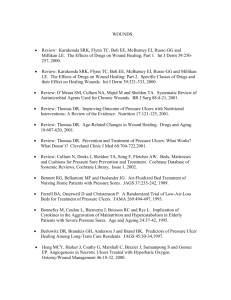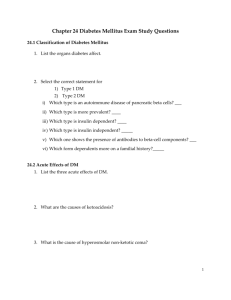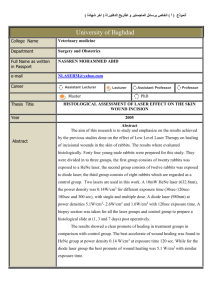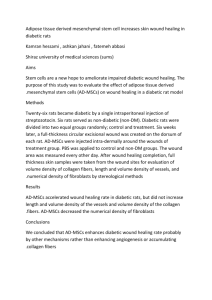1 Biophysics is a knowledge that ... biological system, which lead to the new field that study...
advertisement
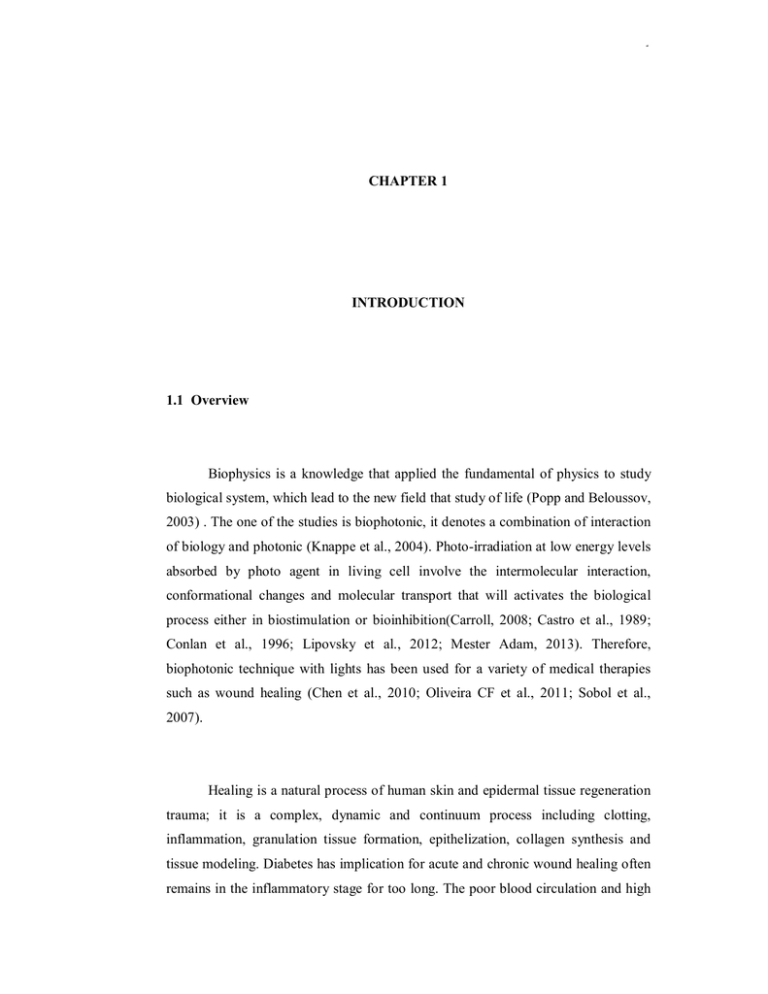
1 CHAPTER 1 INTRODUCTION 1.1 Overview Biophysics is a knowledge that applied the fundamental of physics to study biological system, which lead to the new field that study of life (Popp and Beloussov, 2003) . The one of the studies is biophotonic, it denotes a combination of interaction of biology and photonic (Knappe et al., 2004). Photo-irradiation at low energy levels absorbed by photo agent in living cell involve the intermolecular interaction, conformational changes and molecular transport that will activates the biological process either in biostimulation or bioinhibition(Carroll, 2008; Castro et al., 1989; Conlan et al., 1996; Lipovsky et al., 2012; Mester Adam, 2013). Therefore, biophotonic technique with lights has been used for a variety of medical therapies such as wound healing (Chen et al., 2010; Oliveira CF et al., 2011; Sobol et al., 2007). Healing is a natural process of human skin and epidermal tissue regeneration trauma; it is a complex, dynamic and continuum process including clotting, inflammation, granulation tissue formation, epithelization, collagen synthesis and tissue modeling. Diabetes has implication for acute and chronic wound healing often remains in the inflammatory stage for too long. The poor blood circulation and high 2 glucose level cause poor immune response and makes the cell walls became rigid (Longo L, 2010). The laser therapy to be effective as analgesics and to accelerate the healing of injured tissue and chronic wound (Hawkins D et al., 2005; Hegde et al., 2011; Lowe et al., 1998; Oliveira CF et al., 2008a). The effective of treatment was depending on laser parameter, the complexity of choosing was reported by several authors (Hamblin and Demidova, 2006; Hamblin et al., 2008; Huang et al., 2009). Hawkins et al. (Hawkins D et al., 2005) has report that the visible red and infrared wavelength revealed to have highly absorbent and unique therapeutic effects in living tissues. Gungormus et al., (Güngörmüş and Akyol, 2009b) evaluated the inflammation and re-epithelialization using near infrared laser to exposure cells in vivo stated that the treatment schedule of irradiation are more important than the total energy dose in biostimulatory. Different lasers have been applied; the beneficial biological effects and negative results were reported (Enwemeka et al., 2004; Lau et al., 2014b; Rezende et al., 2007b; Stadler et al., 2001). Several studies have claimed that the high power exposure have showed inhibit effects in healing process and causing decrease in cell viability as well as increase cell damage in vivo and vitro experiment (Hawkins Denise H and Abrahamse, 2006; Nussbaum et al., 2003; Rodrigo et al., 2009; Romanos et al., 1995). 1.2 Problem statement Malaysia was ranked sixth in the Asia-Pacific region and tops the list in SouthEast Asia for diabetes stated by Prof Dr.Mohd Ismail Noor,the president of Malaysian Society for the Study of Obesity (Audrey E., 17thNovember 2013).Diabetes can develop a foot ulcer that exhibit impaired healing, including delayed acute wounds and chronic wounds, generally have failed to progress through 3 the normal stages of healing. Some ulcers can be deep necrosis as the muscle and even bone, the infection is lost control and cure. Therefore, many patients with foot ulcers were forced to accept the amputation. Amputation wound is difficult to heal because of poor bloodsupply, the second amputation will be taken. Diabetic subjects had a 55% greater risk of death than those without diabetes for limb amputation (Schofield et al, 2006). Unfortunately, amputation not the solution for foot ulcer continues necrosis.After amputation caused the walking inconvenient, the overload of other leg will be easier lead to leg abrasion, falls or bumps caused by the new foot ulcers. However, the right medicine for diabetes has not yet been found. The final outcome: ulcers, amputation and death. Therefore, the treatment for foot ulcer is the key to preventing death, before the foot ulcers necrosis. Alternative methods to treat diabetic need to be considered. In this project, laser treatment was introduced to cue and prevent the necrosis. The laser parameters was including power density as well as the time of exposure, these are keys of treatment. 1.3 Objective The main objective of this research is to investigate the biophotonic effects of infrared laser diode 808 nm on diabetes wound healing process. This is accomplished by the following tasks: i. To determine the appropriated dosage of Streptozotocin (STZ) for diabetes induction ii. To examine the effect of infrared laser diode on collagen production via tensile strength test in diabetes rat model 4 iii. To determine the effects of infrared laser diode on diabetes wound healing based on analysis of macroscopic (wound size by digital camera capture) and microscopic (Histology examination by Hematoxylin and Eosin stain) 1.4 Scope In this work, a diabetic disease was studied in vivo model, several aspects are considered to limit the scope of the study. In this project a diode 808 nm with power in the range of 100- 500 mW was employed as a source of treatment. The duration was varied from 1 to 50 s.300 Sprague Dawley ratweighing between 200-250g and 12 weeks of age were chosen as samples,because they have similar properties as human skin. Diabetic was induced using Streptozotocin (STZ). The validation of diabetic was carried out via blood test. The diabetic wound was induced via 6 mm wound punch. Macroscopic and microscopic measurements were be taken. The technique to studies the sample was through tensile strength, wound contraction and histology examination.This work have approval by UniversitiKebangsaan Malaysia Animal Ethics Committee (UKMAEC) with approval code UTM/APSI/2013/NORIAH/20-MARCH/502-MARCH-2013-JAN.-2015. 1.5 Significant of Study The finding of this study will be beneficial for medical industry especially for those patients with diabetic diseases. Hopefully with the infrared laser irradiation associated with conventional treatment will help to reduce the time for healing and greater chance to safe more life. Furthermore, laser diode is a cost effective device, many diabetic patients can afford to do the treatment. Yet the portable laser system allows the treatment to be performed at nearby clinical instead of hospital. In fact there are possibilities to execute the treatment at home 5 1.6 Thesis Outline This research is organized in the following way: chapter one provides a brief introduction to the problem addressed in this research and the significance of the work. The specific aims and objectives of the project are also outlined and summarized. Chapter two presents some literature reviews on related work and some basic definitions and background in this work. Chapter three includes the experimental set up and the methodology in detail. Chapter four provides the results and discussion of the research work and chapter five includes the conclusion with some recommendations to further develop the work in the future.
